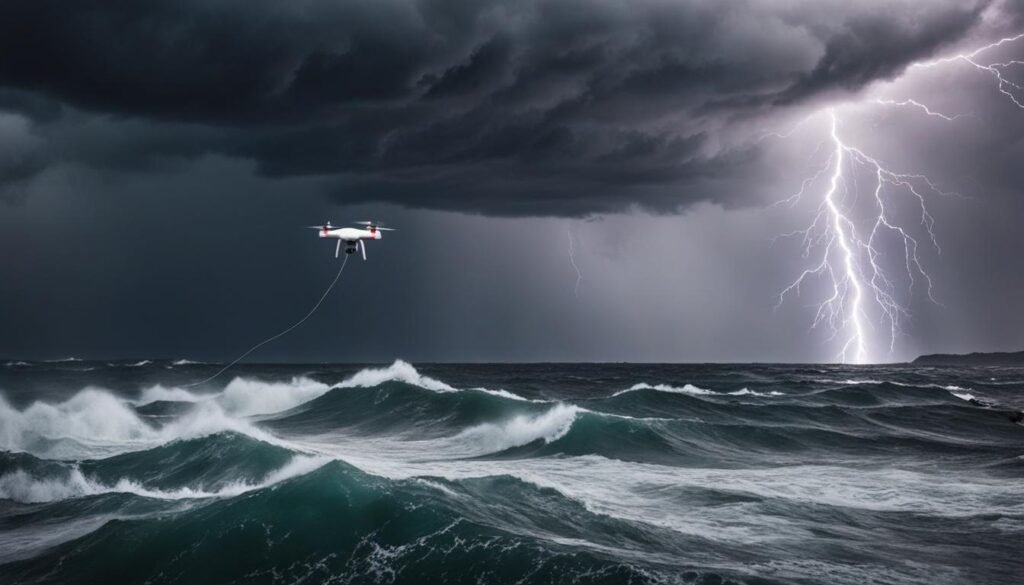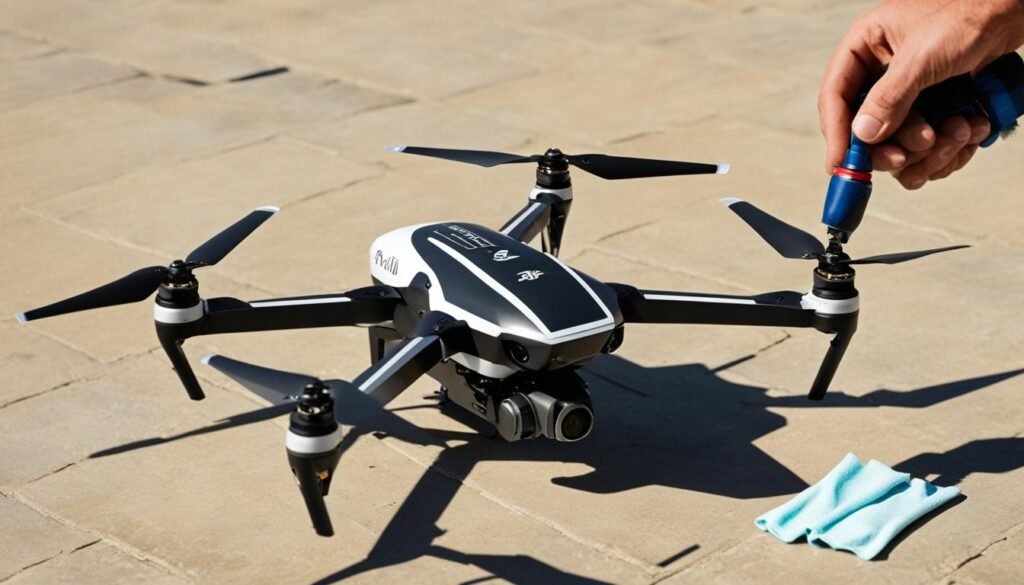Drone fishing comes with its own set of challenges and risks, and it’s essential to be well-prepared and informed. By understanding and implementing these safety measures, you can minimize potential risks and make the most out of your drone fishing experience.

Understanding the Safety Protocols of Drone Fishing
Before embarking on your drone fishing adventure, it is essential to familiarize yourself with the safety protocols specific to drone fishing. By following these guidelines, you can ensure a safe and enjoyable experience. This section will cover three important aspects of drone fishing safety: pre-flight calibration and battery checks, interpreting drone control signals and indicators, and utilizing manual mode for greater control.
Pre-Flight Calibration and Battery Checks
Proper pre-flight calibration and battery checks are crucial to ensure that your drone is in optimal condition for a safe flight. Before each fishing expedition, make sure to calibrate your drone according to the manufacturer’s instructions. This calibration process ensures that your drone’s sensors are accurately detecting its position and orientation, allowing for stable flight during fishing operations. Additionally, check your drone’s battery health and ensure it is adequately charged to support the duration of your fishing trip.
Interpreting Drone Control Signals and Indicators
Understanding the drone control signals and indicators is vital for making informed decisions while in flight. Familiarize yourself with the various control signals and indicators provided by your drone’s remote controller or mobile app. This knowledge will enable you to monitor battery levels, GPS signal strength, and other critical flight parameters. By interpreting these signals correctly, you can proactively address any potential safety issues and maintain optimal control of your drone.
Manual Mode Utilization for Greater Control
Utilizing the manual mode of your drone provides you with greater control over its movements, enhancing safety during fishing operations. This mode allows you to override the drone’s automated flight functions and manually pilot it. By using manual mode, you can navigate your drone more precisely, adjust its altitude and speed according to the fishing conditions, and mitigate potential hazards. However, it is essential to practice and gain proficiency in manual mode before attempting complex maneuvers.
Key Safety Features in Modern Fishing Drones
Modern fishing drones are equipped with advanced safety features to ensure a secure and enjoyable drone fishing experience. These safety technologies play a vital role in minimizing risks and enhancing the overall safety of drone fishing. Here are some key safety features to consider when choosing a fishing drone:
Loss of Signal Auto Return: A Vital Safety Net
One of the essential safety features in fishing drones is the loss of signal auto return function. This feature automatically brings your drone back to the original starting point in case it goes out of range or experiences a control signal issue. It acts as a safety net, ensuring that your drone doesn’t get lost or fly uncontrollably, even in challenging conditions.
Battery Life Monitoring and Low Voltage Protocols
Battery life monitoring and low voltage protocols are critical safety features in fishing drones. These features provide real-time information about the battery’s remaining power and help prevent unexpected power failures during flight. By monitoring battery life and implementing low voltage protocols, fishing drones can automatically land or return to the starting point when the battery reaches a low level, ensuring safe and controlled operations.
Anti-Interference Systems Enhancing Flight Stability
To enhance flight stability and reduce the risk of signal disruption, fishing drones incorporate anti-interference systems. These systems help minimize the impact of external factors such as electromagnetic interference or competing signals, ensuring a stable and reliable connection between the drone and the controller. As a result, you can fly your fishing drone with confidence and peace of mind, knowing that it will maintain steady flight performance even in interference-prone environments.
Considerations When Flying In Strong Wind or Bad Weather

When it comes to drone fishing, flying in strong winds or bad weather conditions can present additional challenges and risks. However, with the right considerations and preparations, you can still enjoy a successful fishing experience even in challenging weather conditions.
Firstly, it’s important to assess the wind speed and direction before taking off. Strong winds can significantly affect the stability and control of your drone, posing a risk of crashes or loss of control. Be sure to check the weather forecast and use a reliable wind speed indicator to determine if it’s safe to fly.
Choosing the right flying locations is also crucial. Look for areas with natural windbreaks, such as cliffs or buildings, which can provide some protection against strong winds. Avoid open spaces or bodies of water where the wind can have a stronger impact on your drone.
When flying in challenging weather conditions, it’s essential to maneuver your drone safely and effectively. Maintain a steady altitude and avoid sudden movements, as strong winds can easily push your drone off course. Use gentle and precise controls to navigate through the wind, ensuring the stability of your drone and the fishing line.
Remember to always prioritize your safety and the safety of others around you. If the weather conditions are too severe or pose a risk to yourself or property, it’s best to postpone the drone fishing trip. Being proactive and making informed decisions when it comes to flying in strong winds or bad weather conditions can help prevent accidents and ensure a positive fishing experience.
Maintaining Your Drone for Optimal Function and Safety

Proper maintenance is essential to ensure that your drone functions optimally and safely during your fishing expeditions. By following these maintenance tips and best practices, you can keep your drone in top shape and prolong its lifespan while preserving its safety features.
To start, regular cleaning and inspection of your drone is crucial. Use a soft cloth or brush to remove any dirt, dust, or debris from the body, propellers, and camera. Pay special attention to the motor and gimbal, ensuring they are free from any obstructions that could affect performance. Inspect the drone for any signs of damage, such as cracks or loose parts, and address them promptly.
Battery care is another critical aspect of drone maintenance. Always follow the manufacturer’s instructions for charging and storing your drone’s batteries. Make sure to use the correct charger and avoid overcharging or discharging the batteries excessively. It’s also a good practice to regularly check the battery voltage and replace any batteries that are showing signs of deterioration.
Firmware updates are crucial for keeping your drone up to date with the latest features and bug fixes. Periodically check for firmware updates from the drone manufacturer and follow their instructions for updating the firmware. This will ensure that your drone operates smoothly and safely.
General upkeep is also important in maintaining the overall function and safety of your drone. Make sure to store your drone in a dry and secure location when not in use. Avoid exposing it to extreme temperatures or direct sunlight for extended periods. It’s also recommended to have a dedicated carrying case to protect your drone during transport.
Integrating Advanced Drone Fishing Technology Responsibly
With the continuous advancement of drone fishing technology, it is crucial to integrate these innovations responsibly and ethically. By doing so, you can effectively practice responsible drone fishing, adopting ethical practices that contribute to sustainable drone fishing.
The Benefits of Built-In Weighing Systems for Load Management
One significant benefit of advanced fishing drones is the integration of built-in weighing systems. These systems allow you to accurately measure the weight of your catch while in flight, eliminating the need for manual weighing post-retrieval. By utilizing this feature, you can efficiently manage the load capacity of your drone, ensuring that you stay within the safe operating limits. This not only enhances the safety of your drone fishing experience but also promotes responsible fishing practices.
Water Resistance and Flotation Capabilities for Over-Water Safety
When engaging in drone fishing over water bodies, it’s crucial to consider the safety features of your fishing drone. Look for drones that offer water resistance and flotation capabilities. These features provide an added layer of protection in case of accidents or emergencies, allowing your drone to stay afloat and minimizing the risk of damage or loss. By prioritizing over-water safety, you can safeguard not only your equipment but also the surrounding ecosystem, practicing ethical drone fishing.
Choosing the Right Drone Fishing Equipment for the Conditions
When selecting your drone fishing equipment, it is essential to consider the specific conditions in which you will be fishing. Different environments and weather conditions may require different drone specifications and features. For example, fishing in high wind conditions may necessitate a drone with advanced stabilization capabilities. By choosing the right equipment for the conditions, you can enhance the safety and efficiency of your drone fishing, ensuring sustainable practices and an enjoyable experience.
The Future of Drone Fishing and Safety Innovations
As drone fishing continues to gain popularity, the future of this exciting activity holds great promise. Advancements in drone technology are constantly being made, with a particular focus on improving safety and enhancing the overall drone fishing experience. These innovations will undoubtedly shape a safer and more enjoyable future for drone fishermen.
One notable area of advancement is the development of intelligent obstacle avoidance systems. These systems use advanced sensors and algorithms to detect and avoid obstacles in real-time, significantly reducing the risk of collisions during flight. With this technology, you can navigate through challenging environments with peace of mind, knowing that your drone is equipped to steer clear of potential hazards.
Another exciting development is the integration of artificial intelligence (AI) in drone fishing. AI-powered drones have the potential to analyze environmental conditions, such as water temperature and current, and provide valuable insights to improve your fishing strategy. Additionally, AI can assist in identifying safe and legal areas for drone fishing, ensuring you remain compliant with regulations and guidelines.
Furthermore, the future of drone fishing will likely see the emergence of advanced safety features designed to enhance the pilot’s control and awareness. For example, we can anticipate the implementation of automatic flight termination protocols that halt the drone’s operation if it detects unsafe conditions or malfunctions. This level of built-in safety ensures that your drone always prioritizes your well-being.
Looking For More Fishing Gear?
Check out our other articles about fishing gear and fishing gear reviews
